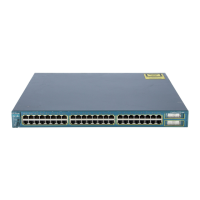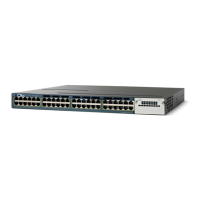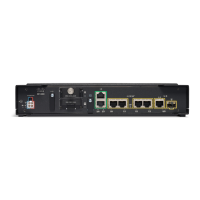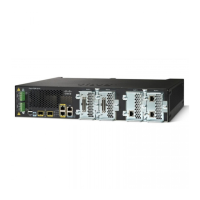29-45
Catalyst 3550 Multilayer Switch Software Configuration Guide
78-11194-09
Chapter 29 Configuring QoS
Configuring Standard QoS
Step 8
trust [cos | dscp | ip-precedence] Configure the trust state, which selects the value that QoS uses as the
source of the internal DSCP value.
Note This command is mutually exclusive with the set command
within the same policy map. If you enter the trust command,
then skip Step 7.
By default, the port is not trusted. If no keyword is specified when the
command is entered, the default is dscp.
The keywords have these meanings:
• cos—QoS derives the internal DSCP value by using the received or
default port CoS value and the CoS-to-DSCP map.
• dscp—QoS derives the internal DSCP value by using the DSCP
value from the ingress packet. For non-IP packets that are tagged,
QoS derives the internal DSCP value by using the received CoS
value; for non-IP packets that are untagged, QoS derives the
internal DSCP value by using the default port CoS value. In either
case, the internal DSCP value is derived from the CoS-to-DSCP
map.
Note If you use the mls qos cos policy-map global configuration
command, you must use the dscp keyword.
• ip-precedence—QoS derives the internal DSCP value by using the
IP precedence value from the ingress packet and the
IP-precedence-to-DSCP map. For non-IP packets that are tagged,
QoS derives the internal DSCP value by using the received CoS
value; for non-IP packets that are untagged, QoS derives the
internal DSCP value by using the default port CoS value. In either
case, the internal DSCP value is derived from the CoS-to-DSCP
map.
For more information, see the “Configuring the CoS-to-DSCP Map”
section on page 29-52.
Step 9
set {cos new-cos | ip dscp new-dscp | ip
precedence new-precedence}
Classify IP traffic by setting a new value in the packet.
• For cos new-cos, enter a new CoS value to be assigned to the
classified traffic. The range is 0 to 7.
Note If you use the mls qos cos policy-map global configuration
command, you must use the cos new-cos keyword.
• For ip dscp new-dscp, enter a new DSCP value to be assigned to
the classified traffic. The range is 0 to 63.
• For ip precedence new-precedence, enter a new IP-precedence
value to be assigned to the classified traffic. The range is 0 to 7.
Command Purpose

